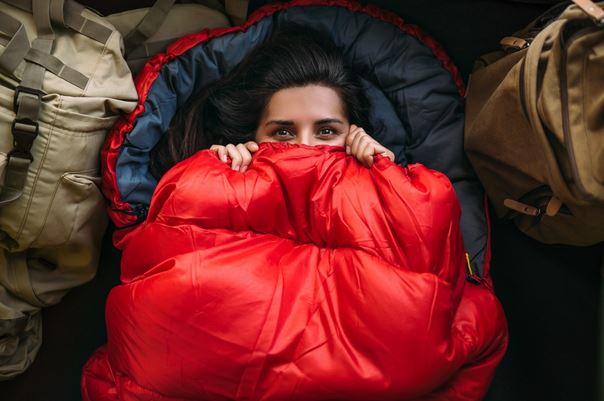This blog post may contain affiliate links. As an Amazon Associate I earn from qualifying purchases.
Camping is an incredible way to connect with nature, but staying warm in my tent becomes a top priority when the temperature drops. Nobody wants to shiver through the night or wake up feeling like a human popsicle. In this guide, I’ll explore the best strategies for how I keep warm in my tent so that you can enjoy a comfortable and cozy camping experience even in chilly conditions.
How I Keep Warm in My Tent?
Choosing the Right Tent
The selection of the right camping tent is an important decision that significantly influences how warm and comfortable I’ll be during a cold-weather camping trip. I generally opt for a Four-Season or Cold-Weather Tent. These tents are purpose-built to tackle the harshest camping conditions. They have three key features which other tents lack;
- Heavier Materials
Four-season tents are constructed with sturdier materials that can withstand stronger winds and snow loads. This extra durability ensures that my tent remains stable and intact even when the weather is challenging. - Better Insulation
These tents come equipped with enhanced insulation, which helps trap heat and maintain a warmer interior temperature. Proper insulation minimizes the impact of frigid outdoor conditions on my comfort inside the tent. - Snow Skirts
Many four-season tents have snow skirts, which are flaps that cover the lower portion of the tent, helping to seal out cold drafts and blowing snow.
Insulating My Tent
The first time I went winter camping without insulating my tent…let’s just say I learned about the importance of preparation the hard way. Shivering under a single sleeping bag, in what felt like a walk-in freezer, I vowed never to make that mistake again.
Since then, I’ve learned that insulating my tent involves creating a barrier within it to retain warmth and protect against cold outdoor conditions. This insulation primarily focuses on preventing heat loss, keeping the interior temperature comfortable.
It can be achieved through proper tent selection (choosing four-season or cold-weather tents), using ground cloths or footprints to insulate from the cold ground, and adding extra rainflies for enhanced protection against cold and moisture. By effectively insulating my tent, I ensure a warmer and more comfortable camping experience, even in the face of low temperatures, strong winds, and snow.
- Using a Footprint
Placing a footprint or ground cloth beneath my tent is a smart move. Not only does it provide an additional layer of protection for my tent’s floor, but it also acts as insulation, preventing heat loss through the ground. This simple barrier between my tent and the cold earth can make a noticeable difference in preserving warmth. - Considering Adding an Extra Rainfly
While my tent comes with a built-in rainfly, attaching an extra one can offer enhanced protection against cold and moisture. This secondary rainfly acts as an extra shield, safeguarding my tent from the elements and adding another layer of insulation. It’s particularly valuable during wet and windy winter conditions, as it minimizes the chances of rain or snow penetrating my tent.
Proper Sleeping Gear
My choice of sleeping gear is crucial in staying warm. I opt for a sleeping bag rated for the lowest expected temperature during my trip. Sleeping pads also provide insulation from the cold ground and add comfort.
Staying warm and comfortable inside my sleeping bag and on my sleeping pad is crucial for an enjoyable cold-weather camping experience.
Also Read: Essential Tent Camping Gear Checklist
Consider a Mummy-Style Sleeping Bag

When it comes to sleeping bags for cold-weather camping, the design matters. A mummy-style sleeping bag is my top choice for maximum warmth. Here’s why:
- Close-Fitting Design
Mummy bags are narrower around the legs and feet and have a snug hood that can be cinched around my head. This close-fitting design minimizes the interior space, which means there’s less air to heat. It wraps me up like a cocoon, preventing cold spots and maximizing warmth. - Draft Collars and Zippers
Many mummy bags also feature draft collars and draft tubes along the zippers to further seal in warmth and prevent cold air from seeping in. These features ensure that I stay toasty throughout the night. - High-Quality Insulation
I always opt for a mummy bag with high-quality insulation, such as down or synthetic fill, specifically designed for cold temperatures. These materials provide excellent warmth-to-weight ratios and are known for their insulating properties.
Invest in an Insulated Sleeping Pad

My choice of a sleeping pad is equally important. An insulated sleeping pad not only adds comfort but also acts as a crucial barrier between me and the cold ground. Here’s why it’s worth the investment:
- Insulation Against the Cold Ground
Insulated sleeping pads come with added layers of insulation, which help to prevent heat loss to the ground. They effectively create a buffer that keeps the cold from permeating my body while I sleep, ensuring a warmer and more comfortable rest. - R-Value Consideration
When choosing an insulated sleeping pad, I pay attention to its R-value, which measures its insulating ability. The higher the R-value, the better the pad is at retaining heat. For cold-weather camping, I opt for a pad with a high R-value to provide sufficient insulation. - Comfort and Support
Insulated pads are not just about warmth; they also offer comfort and support, ensuring a more restful night’s sleep, especially on uneven or hard ground.
Also Read: How-To-Keep-Bugs-Out-Of-Tent
Clothing and Layering
Dressing appropriately is key to retaining body heat. I layer my clothing for better insulation. I start with moisture-wicking base layers, add insulating layers, and finish with a waterproof and windproof outer layer.
- Avoiding Cotton Clothing
Cotton may be comfortable in everyday situations, but it’s the enemy of warmth when it comes to outdoor winter activities. - Moisture Retention
Cotton has a knack for absorbing and retaining moisture, whether it’s from sweat or environmental factors like rain or snow. When it becomes wet, cotton loses its insulating properties and, instead, draws heat away from my body. This can lead to a significant drop in body temperature, making me feel uncomfortably cold. - Slow Drying
Cotton dries at a snail’s pace, especially in cold and damp conditions. If my clothing becomes wet, it can take a long time to dry out, leaving me in wet and cold clothes for extended periods.
Moisture-Wicking Fabrics, Warm Socks, and Hats
To stay warm in cold weather, I opt for clothing made from moisture-wicking fabrics like merino wool or synthetic materials. Here’s how these choices can help:
- Moisture Management
Moisture-wicking fabrics pull sweat and moisture away from my skin and distribute it across the fabric’s surface, allowing it to evaporate quickly. This keeps me dry and minimizes the risk of feeling cold due to wet clothing. - Warm Socks
Cold feet can make the rest of my body feel cold, too. Insulated, moisture-wicking socks are crucial to keeping my feet warm and dry. I look for thick, woolen options that provide both insulation and moisture management. - Hats for Heat Retention
A significant portion of my body’s heat is lost through my head. Wearing a warm, insulating hat is essential for preserving body heat. I opt for a hat that covers my ears for added protection against the cold. - Heating Methods
Adding a heat source to my tent can significantly improve comfort. If safe and appropriate, I use tent-safe heaters. Hot water bottles or chemical hand warmers can also provide localized warmth.
Tent Heaters Safety
Using a heater inside my tent can make a considerable difference in maintaining a comfortable temperature, but safety is non-negotiable. Here’s why it’s crucial to follow safety guidelines:
- Flammable Materials
Keep the heater away from any flammable materials, including my sleeping bag, clothing, and tent walls. The consequences of accidentally igniting these materials can be catastrophic in a confined space like a tent. - Unattended Heaters
I never leave a heater unattended. Even if it’s equipped with safety features, such as automatic shut-off mechanisms, I should always be vigilant while the heater is operating. An unexpected malfunction could pose a danger. - Ventilation
I ensure that my tent is adequately ventilated when using a heater. Proper airflow is essential to prevent the buildup of carbon monoxide, which can be harmful. Most tent heaters are designed with this consideration in mind and have ventilation features.
Using Hot Water Bottles
Hot water bottles are a time-tested method for generating some extra warmth in my sleeping bag. Here’s how to use them effectively:
- Preparing Hot Water Bottles
I fill a hot water bottle with hot (not boiling) water before bedtime. It’s essential not to use boiling water, as this can damage the bottle and cause burns. - Positioning in My Sleeping Bag
I place the hot water bottle at the foot of my sleeping bag. This not only warms my feet but also radiates warmth throughout the bag, helping me stay comfortable throughout the night. - Securely Seal the Bottle
I make sure the hot water bottle is securely sealed to avoid any leaks that could result in a wet sleeping bag.
Final Thoughts – Keep Warm While Camping
Keeping warm in my tent while camping in cold weather doesn’t have to be a challenge. By choosing the right equipment, dressing appropriately, and utilizing safe heating methods, I can ensure a cozy and enjoyable camping experience even in the chilliest of conditions. Remember, preparation is the key to a warm and memorable camping adventure.
Thank you for reading my guide on how to keep warm in a tent. For more camping tips and advice, be sure to explore our website. Happy camping and stay warm!
FAQs
What type of tent is best for camping in cold weather?
For cold-weather camping, a four-season or cold-weather tent is ideal. These tents are made with sturdier materials to handle strong winds and snow. They also have enhanced insulation to trap heat and often include snow skirts, which prevent cold drafts from entering.
How can I keep my tent warm without a heater?
To keep your tent warm without a heater, focus on insulating it. Use a footprint or ground cloth beneath your tent to block ground cold, add an extra rainfly to protect against wind and moisture, and consider insulating your sleeping area with a high-R-value sleeping pad and a cold-rated sleeping bag.
What kind of clothing should I wear for winter camping?
Layering is essential. Start with a moisture-wicking base layer, add insulating layers, and finish with a waterproof and windproof outer layer. Avoid cotton as it retains moisture, which can make you colder. Instead, choose materials like merino wool or synthetic fabrics that wick moisture and dry quickly.
Are tent heaters safe to use?
Tent heaters can be safe if you follow essential safety guidelines. Always ensure adequate ventilation to prevent carbon monoxide buildup, keep the heater away from flammable materials, and never leave it unattended. For extra warmth, consider using a hot water bottle, which is safe and effective when properly used.


